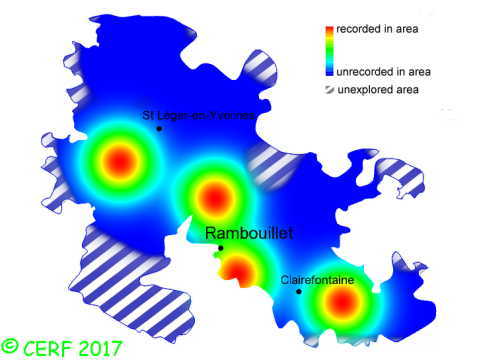|
Xerocomus ripariellus Redeuilh.
|
New classification: Basidiomycota/Agaricomycotina/Agaricomycetes/Agaricomycetidae/Boletales/Boletaceae
Former classification: Basidiomycota/Homobasidiomycetes/Agaricomycetideae/Boletales/Boletaceae
synonyms: Xerocomellus ripariellus, Boletus ripariellus, Xerocomellus ripariellus
edibility : unknown edibility
|
|
|
The cap is reddish, pinkish, apricot-brown to grey-brown, hemispherical, then convex.
The cap surface is matt, dry, downy then soon cracking when drying starting from the margin.
The stem is yellow at first, remaining so at the apex, becoming reddish brown, cylindrical or tapering towards base.
The flesh is yellowish to cream, brownish at the stem base, turning blue when cut especially in the stem at mid-height; its taste is mild, faint; the odour is faint or indistinct;
The tubes are whitish-yellow to yellow then olive-yellow, adnate.
The pores are concolorous to tubes, large and angular, turning blue when pressed.
The spore print is olivaceous-brown.
It grows in deciduous woodland, in damp areas close to streams or ponds, on a rather damp soil, under willow, alder, poplar, also under pine or oak.
The fruiting period takes place from August to October.
| Dimensions: | width of cap approximately 6 cm (between 3 and 10 cm) |
| | height of stem approximately 5 cm (between 3 and 8 cm) |
| | thickness of stem (at largest section) approximately 14 mm (between 5 and 25 mm) |
Distinctive features : cap with reddish tones; cap surface cracked radially at the margin then everywhere; yellow pores turning blue when pressed; yellow flesh, brown at stem base, turning a bit blue at stem's mid-height; in wet areas, with alder, willow
Xerocomus ripariellus is quite rare and localised in the forest of Rambouillet, and is infrequent, more generally speaking
.
|  | | Above : distribution map of Xerocomus ripariellus in the forest of Rambouillet |
|
page updated on 14/01/18
